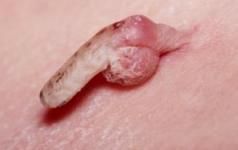Cutaneous Horn: A Benign Growth That May Signal Disease

A 26-year-old man presented with a pigmented lesion at the left posterior axillary area that he said had been there “for as long as he could remember.” One year ago, the lesion began to grow with a typical cutaneous horn that now measured approximately 2 cm (Figure).
The lesion was excised in the office under local anesthesia and the base was electrodesiccated. The wound was dressed with antibiotic ointment and healing was uneventful. Pathologic examination of the lesion revealed a benign squamous papilloma with epidural hyperplasia, prominent hyperkeratosis, and focal cutaneous horn formation.
Discussion
A cutaneous horn is a surface accumulation of keratin found on lesions such as warts, seborrheic and actinic keratoses, and squamous cell carcinomas.1 They usually occur on the face, ears, and hands.
Treatment includes cryotherapy and local scissor or surgical excision with electrocautery of the remaining base or suturing, depending on the horn’s size and location.
Tissue biopsy and pathologic examination are desirable, since cutaneous horns can develop in lesions that are malignant. A small percentage of horns arise in squamous cell carcinomas.
If there is any uncertainty regarding complete excision of a lesion with carcinoma at the base, follow-up or re-excision may be indicated.
Teaching Points
• Cutaneous horns are common, but they can arise within lesions that are malignant. Biopsy of the underlying lesion is therefore recommended.
• Cutaneous horns can be easily excised in the primary care physician’s office.
References:
Reference
1. Habif MD, Thomas P.
Clinical Dermatology: A Color Guide to Diagnosis and Therapy.
5th ed. Mosby Elsevier; 2010:786.